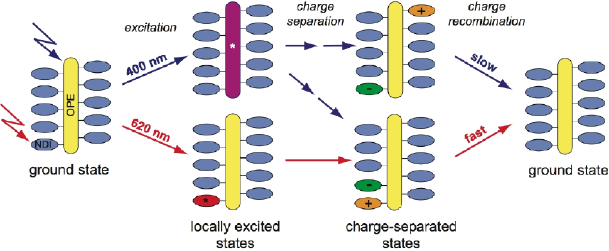The photophysical properties of two hybrid multichromophoric systems consisting of an oligophenylethynyl (OPE) scaffold decorated by 10 red or blue naphthalene diimides (NDIs) have been investigated using femtosecond spectroscopy. Ultrafast charge separation was observed with both red and blue systems. However, the nature of the charge-separated state and its lifetime were found to differ substantially. For the red system, electron transfer occurs from the OPE scaffold to an NDI unit, independently of whether the OPE or an NDI is initially excited. However, charge separation upon OPE excitation is about 10 times faster, and takes place with a 100 fs time constant. The average lifetime of the ensuing charge-separated state amounts to about 650 ps. Charge separation in the blue system depends on which of the OPE scaffold or an NDI is excited. In the first case, an electron is transferred from the OPE to an NDI and the hole subsequently shifts to another NDI unit, whereas in the second case symmetry-breaking charge separation between two NDI units occurs. Although the charges are located on two NDIs in both cases, different recombination dynamics are observed. This is explained by the location of the ionic NDI moieties that depends on the charge separation pathway, hence on the excitation wavelength. The very different dynamics observed with red and blue systems can be accounted for by the oxidation potentials of the respective NDIs that are higher and lower than that of the OPE scaffold. Because of this, the relative energies of the two charge-separated states (hole on the OPE or an NDI) are inverted. |




